Main Menu
Latest Blog Entry
User login
Should I use a foam roller in my warm up?
Foam rolling is very popular in some parts of training, one of the questions we are asked is “How Can I use a foam roller in my warm up?” Here is an in depth look at that, with references and some exercises shown.
What is Foam rolling?
The myofascial system is made up of muscle and fascia, a tough sheet of connective tissue that envelopes muscle fibres. Through injury, overtraining, poor posture, poor movement mechanics and insufficient recovery, painful “trigger points” can build up in the myofascial system.
These trigger points are often described as adhesions and occur in areas of tight muscle where muscle fibres and fascia effectively become stuck together. This can restrict movement about a joint, and also places strain on surrounding tissues which must compensate for the weakness and can lead to injury.
Myofascial release is a massage technique used to break down the adhesions and increase extensibility of the muscle. There are two types of myofascial release which are used by practitioners:
1) Direct Pressure- direct pressure to adhesion, breaks down adhesions and scar tissue
2) Sweeping pressure- long strokes along full length of muscle, reduces muscle tension and promotes soft tissue extensibility.
Foam rolling is a technique for self administering myofascial release. The technique involves applying pressure to the target area using the foam roller, and manipulating the position by rolling backwards and forwards along the length of the muscle.
Using the foam roller is a cost effective way of achieving full body massage, leading to improved performance and reduced risk of injury.
Some common exercises
The foam roller can be used to treat any tight muscle group, and below are some of the most common exercises for major muscles of the lower body.
Hamstrings–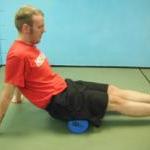
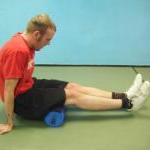
Glutes- 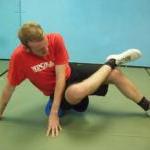
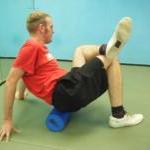
Thighs-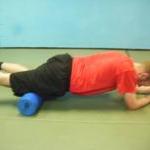
Should a foam roller be used during warm ups?
There is a growing body of evidence detailing the benefits of foam rolling/myofascial release but when is the most effective time to implement it?
Pre-Training:
There is a wealth of anecdotal support for the use of foam rolling before training. Experienced practitioners such as Dr David Ginsberg (2010 team chiropractor for Chicago Slaughter Professional Indoor Football team, current injury consultant for St. Charles Gymnastics Academy) advocates the use of foam rolling, using superficial sweeping pressure techniques, in warm ups to relax and loosen tight muscle groups.
The use of this technique has also been supported by a recent study by D’Amico & Morin (2011). Following a foam roller warm up protocol of 15 strokes back and forth along the hamstrings, subjects improved static strength and jump performance whilst also maintaining range of motion compared to a control group performing static stretching.
However, the mechanism by which static strength and power were improved in this study was suggested to be an increase in muscle temperature. Therefore any warm up strategy including dynamic stretching and low load movement could result in a similar improvement in performance.
Although the volume of research conducted into pre-exercise myofascial release and massage is limited, the majority of studies have found no benefit to performance compared to control trials.
Studies by Harmer (1991) and Goodwin et al., (2007) found that pre-performance massage had no significant effect on subsequent sprint performances. Furthermore, Fletcher (2010) found that fast, superficial myofascial release techniques used during a warm up resulted in slower sprint performances than an active warm up.
It should also be noted that myofascial release practitioners warn against using the direct pressure technique immediately before training or competition. Direct Pressure will break up scar tissue and result in an inflammatory response. Exercising immediately after this could result in further inflammation and possibly injury.
Post Training:
There has been extensive research on the effects of foam rolling when used post training. A review by Bret Contreras and Chris Beardsley (S+C Research December, 2014) describes two recent studies looking at effects on recovery from training, and on mobility.
A study by Kim et al., (2014) investigated the effect of foam rolling on recovery from physical stress. Participants performed 30 minutes of exercise followed immediately by foam rolling or passive rest, with levels of the stress hormone cortisol then measured and compared.
The researchers found that there was no significant difference in reduction of cortisol between the two groups. This suggests that foam rolling immediately post training/competition has little impact on recovery.
However, a study by Mohr et al., (2014) showed more positive effects of foam rolling. Participants completed one of three different mobility programmes over the course of a week (foam rolling, stretching, foam rolling and stretching; there was also a control group with no programme).
All three groups increased passive hip flexion ROM, with static stretching (12°) being twice as effective as foam rolling (6°). However when combined together, the effects of stretching and foam rolling (23.5°) were almost twice as effective compared to stretching alone.
Conclusions
Foam rolling has been shown to significantly increase mobility when performed in conjunction with traditional stretching routines. Using the foam roller every day before stretching exercises looks to enhance mobility which could impact on both performance and injury prevention.
This could be done either after training, or at a later part of the day away from training, as research suggests no benefit of rolling immediately post-training.
Despite popularity and anecdotal support for using foam rollers before training and competition, there is no evidence to suggest they provide any benefit to performance or injury prevention compared to more active warm up techniques.
Once more, there is a potential danger of injury if used excessively prior to training or competition. Dynamic active warm ups should still be the major focus when preparing an athlete for training or competition.
Matt Durber
References
Beardsley, C. and Contreras, B. (2014) Strength and Conditioning Research, December (Foam roller edition).
D’Amico, A. and Morin, C. (2011) Effects of Myofascial Release on Human Performance. In association with Bridgewater State University. Retrieved from http://www.fiteval.com/Site_1/Research_Study.html
Goodwin, J.E., Glaister, M., Howatson, G., Lockey, R.A., and McInnes, G. (2007) Effect of Pre-performance Lower-Limb Massage on Thirty-Meter Sprint Running. Journal of Strength and Conditioning Research, 21 (4), 1028-1031.
Fletcher, IM. (2010) The effects of precompetition massage on the kinematic parameters of 20-m sprint performance. Journal of Strength and Conditioning Research, 24(5), 1179-83.
Harmer, P. (1991) The effect of pre-performance massage on stride frequency in sprinters. Journal of Athletic Training, 26, 55-8.
Kim, K., Park, S., Goo, B.O., and Choi, S.C. (2014) Effect of self-myofascial release on reduction of physical stress: a pilot study Journal of Physical Therapy Science, 26 (11), 1779-1781.
Mohr, A.R., Long, B.C., and Goad, C.L. (2014) Effect of foam rolling and static stretching on passive hip-flexion range of motion Journal of Sport Rehabilitation (forthcoming).
Client Testimonials
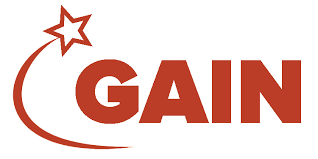 Vern Gambetta: GAIN founder
Vern Gambetta: GAIN founder
James Marshall is the consummate professional, always learning and working to make himself better. His focus is always on the athletes he working to make them better by exploring and discovering the dimensions of movement. He is a longtime active member of the GAIN professional development network. This gives him access to other professionals around […]
More


Comments
[…] Massage- self or other if you are lucky. […]